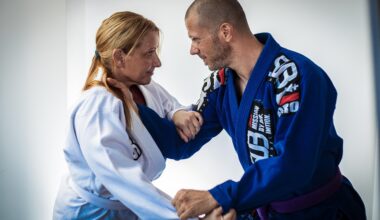Using Screens Successfully as a Small Forward
In basketball, the small forward position is often referred to as the “three” and is crucial for success. A small forward needs to excel in various skills, especially when using screens effectively. One of the primary focuses of training should be on the ability to navigate through screens. Awareness and execution when interacting with screens can create opportunities not only for the small forward but also for teammates. Understanding how to utilize screens also minimizes defensive pressure. Here are key components for success: first, mastering footwork is essential to swiftly change directions. Secondly, always keep your head up to survey passing options after the screen. Thirdly, utilize a quick jab step upon receiving the ball to keep defenders guessing. Fourth, develop a strong shooting technique to capitalize on open looks created by the screen. In addition, communication with teammates is vital to ensure proper timing and placement for effective plays. In practice, simulate different defensive scenarios to enhance your adaptability and skill set, turning the screen into a powerful weapon for your offensive strategy.
The next aspect of using screens involves creating separation. As a small forward, it is critical to create space to receive the ball effectively. This often means using screens effectively to maximize shooting and driving opportunities. After setting a screen, ensure proper angle positioning for effective ball movement. Always look to make a sharp cut after setting the screen to reposition yourself for the ball. Additionally, practicing backdoor cuts can provide another effective route when any defender overcommits. Utilize deceptive movements, including hesitation or deliberate slowdowns, to make your cuts more unpredictable. Knowing how to read the defense is another valuable skill; if the defender goes under the screen, you should be prepared to shoot. Conversely, if they go over the screen, you may want to drive to the basket. It is equally important to practice this with a training partner to simulate real-game scenarios. Attention to detail regarding defenders’ habits helps develop this skill. In training drills, incorporate various angles and types of screens to evaluate how best to maneuver and take advantage of these situations consistently.
The Psychology of Using Screens
Understanding the psychological aspects of using screens is equally important as the physical ones. Your body language and movements play a significant role in how effective your screens will be. If you signal confidently and decisively that you will use the screen, defenders may hesitate, giving you a better angle. Additionally, being aware of your opponents’ psychological tendencies can help anticipate their reactions. If you know a defender is aggressive, use that to your advantage by executing softer screens, allowing for easier cuts. Always keep in mind that screens are not just about physicality; they also rely on perception. Make eye contact with your teammates to establish communication when running through screens. Integration of non-verbal signals creates an unspoken understanding between players, improving execution. As you continue to enhance your usage of screens, also observe and learn from various high-level players. Analyzing their movements, choices, and adaptability can offer insights that elevate your own skills. Engaging in discussions with coaches and teammates regarding screen usage can bring about strategic improvements. Remember, basketball is not just about speed or strength; intelligence is equally crucial.
In preparation for using screens, conditioning plays a crucial role. Your body must be in optimal shape to efficiently navigate through and around screens, as well as maintain your balance when redirected by defenders. Incorporate agility drills into your training regimen to enhance foot speed and quickness. Additionally, plyometric training can help strengthen your legs for explosive movements. Focus on exercises that enhance your lateral movement, which is essential when evading defenders around the screen. Resistance training also improves your overall strength, making it easier to set solid screens. Stretching regularly will improve flexibility, allowing for quicker responses and adjustments during gameplay. Finally, always emphasize teamwork during drills that involve screens. Practicing with fellow players results in a better understanding of how to set and use screens effectively. Trusting your teammates enables better collaboration during games, creating seamless plays. As your conditioning improves, you will notice a smoother execution of screens. These elements combined ultimately contribute to becoming a more effective small forward in your on-court strategy, allowing you to influence the game’s pace and direction ultimately.
Adapting to Different Defenses
Every game presents unique challenges, especially when it comes to defending against screens. As a small forward, adapting to various defensive setups is vital. Whether facing man-to-man defense or zone defense, your approach should change accordingly. Learn how to read the defense and react in real-time to counter various defensive tactics. Understanding how different teams defend screens allows you to exploit mismatches effectively. For example, if a defender is trailing you over the screen, be ready to use your superior shooting skills. Conversely, if a defender switches, make sure you capitalize on the matchup. Practicing against different defensive strategies in training will prepare you for diverse game scenarios. Enhancing adaptability helps in positioning yourself accordingly to receive the ball or create offensive opportunities. Always focus on teamwork when executing plays against specific defenses, as shared insights can lead to better decision-making on the court. Additionally, when facing tougher defenses, communication becomes paramount for ensuring that everyone is aligned on offensive tactics. The more familiar you are with how screens operate against different defenses, the more lethal your offensive strategy becomes.
Lastly, constantly reviewing game footage provides invaluable insights into improving screen usage. Watching recordings of your games enables you to evaluate how effectively you utilize screens. Identify moments where you could have reacted differently or been more effective in your movements. Analyzing successful plays can also provide context to the strategies that work best for you. Focus on how other small forwards perform in similar situations, keeping notes on specific strategies or techniques you want to implement. Engaging with coaches to discuss these details can yield constructive feedback and new tactics to incorporate into your training. Building a library of clips from your gameplay will highlight both successes and areas for improvement. This self-analysis helps to refine your skills further, making you a multi-dimensional threat during games. Stay committed to improving all facets of your game, as continuous growth is key to being a successful athlete. Over time, these habits will greatly enhance your confidence in using screens effectively, allowing you to shine as a valuable player on the court. Remember, basketball mastery comes from dedication and continuous learning.
To conclude, mastering the use of screens as a small forward involves a combination of physical, psychological, and strategic elements. Through effective training and analysis, you can one day become a dominant presence on the court. Focused conditioning and adaptability ensure preparation for various gameplay situations. Lastly, consistent practice and feedback will enhance your overall performance, turning screens into powerful tools for your success. As you integrate these elements into your training, expect to see significant improvements in your game effectiveness. By becoming adept at using screens, you not only enhance your gameplay but also engage your teammates in executing collaborative strategies, reinforcing team dynamics. Stay committed to continuous learning, adapting to challenges, and reviewing performances. Basketball success as a small forward extends beyond the individual to the entire team dynamics. By embracing this comprehensive approach, you will stand out as a successful and well-rounded player, elevating your overall basketball experience. Remember, every player has the potential to be effective, but it takes dedication and focus to become extraordinary.
In summary, dedication to honing small forward skills through screen mastery is essential. Integrate agility, strategy, and psychological awareness into your training regimen. Review game footage for introspective learning and adaptability. By mastering these components, the successful use of screens in your basketball play will significantly enhance your performance. Aim to not only excel through your individual skills but also uplift your team with coordinated plays that utilize screens effectively. Commit to ongoing improvement, consistently pushing the boundaries of your potential on the court. Being a formidable small forward involves active engagement in both training and competition settings. Each practice session stretches understanding, building confidence for future challenges. Continual learning forms a solid foundation for success. Become attuned to the nuances of screen usage and the strategic opportunities it presents. The dedication to mastering screens translates into not just basketball success but enjoyment of the game’s intricacies. As you embark on this journey, embrace the challenges and celebrate your growth. With hard work and commitment, your skills will transform you into a game-changer on the basketball court.


